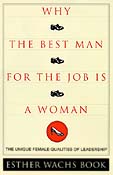According to Esther Wachs Book, “a new breed of leader is emerging, and that breed is female.” Why the Best Man for the Job is a Woman: The Unique Female Qualities of Leadership hails the lady CEO as a sign of a revolution taking place in a corporate culture traditionally dominated by men. The world of business is changing, Book writes, and it is women who are best suited to meet the challenges of the modern marketplace. Book contends that women such as Meg Whitman of eBay and Marcy Carsey of Carsey-Werner succeed because they embody seven uniquely female abilities: they can sell their visions; they are not afraid to reinvent the rules; they are closely focused on achievement; they show courage under fire; they turn challenges into opportunities; they are aware of customer preferences; and they maximize what Book calls “high touch” in an era of high tech. A sort of seven-habits guide for aspiring businesswomen, Why the Best Man for the Job is a Woman profiles 14 of the most successful businesswomen working today, charting their careers in order to show how they gained power by tapping into their femininity. Presenting these women as role models, Book concludes by encouraging readers to emulate them: “With their insights,” she writes, “just imagine what you can do.” Uplifting? Possibly. But only if you can stomach the proposition that women are genetically predisposed to lead and the ugly insinuation that men, as the opposite sex, are not. There can never be too many success stories, and in a world where powerful corporate women are still comparatively rare, women’s stories are especially welcome. Where Book goes wrong is in trying to force these stories to fit a thesis about working women’s innate advantages over their male colleagues. The title says it all: Why the Best Man for the Job is a Woman sets out to promote the idea of women’s corporate fitness by denigrating working men. What presents itself as an inspiring collection of women’s success stories contains a distinctly disturbing message about men – that they aren’t the best people for the job; that they have been made obsolete by the modern, implicitly “feminized” workplace; that they not only lack the leadership characteristics women naturally possess, but that by virtue of their maleness they cannot acquire them. Most damning is the suggestion that men are there to be put down. Representing the book as a guide to “playing with the boys – and beating them at their own game,” Book glibly promises that trouncing men is a fringe benefit of women’s success. As if money, power, and creative license were not enough, Book sells the woman executive as the ultimate victor in the war of the sexes. In a stunning redirection of the intolerance she ostensibly writes against, Book envisions the rise of corporate women as a much-needed means of putting men in their proper place. Book goes to extreme lengths to carry her point. She abandons logic (it is never clear how the seven “uniquely female qualities” of leadership are feminine, let alone female). She hides a lack of evidence behind clever language (calling women leaders a “breed” allows Book to suggest that their talents are inborn without having to prove that they are). And she oversimplifies when she treats a complex historical shift in the structure of business as a biologically inevitable rectification of patriarchal wrongs. The manipulativeness of Book’s argument comes through most forcefully when she discusses the careers of top corporate women. Some do play up their femininity, presenting themselves as mothers or even guardian angels (Darla Moore, formerly of Chemical Bank, liked to walk into boardrooms full of about-to-be-bankrupt businessmen and announce that she was there to “save” them). But others draw on traditionally masculine images, comparing themselves to coaches and military leaders. Still others choose scrupulously neutral terms to describe their leadership philosophy: Orit Gadiesh, senior partner at Bain & Co., says she strives always for “true North,” while Moore notes that “leadership is far more powerful than either gender alone.” Taken together, these examples suggest that far from relying on their innate and irrepressible femaleness to do their jobs, women power brokers depend on their shrewd ability to represent themselves to colleagues, clients, employees, and, yes, feminist authors, in whatever terms are most effective and appropriate to the moment. Where Book makes the women she studies into poster girls for a newly feminine leadership style, the women themselves espouse a much more practical attitude toward gender roles. Consider Marcy Carsey’s tongue-in-cheek comment that women leaders “have to have balls.” Carsey is not saying that successful women have to be like men, but she is saying that they can’t afford to be too tied to the idea that they are “like women,” either. More important than adhering to gender roles, more important even than blurring them, is the ability to convince through surprise and to turn the work of self-promotion into a form of play. For Carsey, as for others like her, success in business depends in no small degree on the ability – and willingness – to manipulate one’s own image. And in this the women Book interviews think very differently than she does about the place of gender in the corporate world. For Book, calling oneself the “parent” of a company, or describing one’s style as “nurturing,” is a way of announcing the inherent power of womanhood. For the women Book writes about, the rhetoric of femininity is just that: rhetoric. Calling oneself a parent or nurturer is for them no more or less accurate than calling oneself a player or an officer: These are words chosen by women who know better than anyone how to sell themselves, and who understand the language of gender to be an important and flexible tool of self-presentation. All told, then, Book’s strained attempt to explain the woman CEO as the result of some sort of corporatized natural selection in which female characteristics triumph over the less-fit traits of men smacks of bad analytical faith. She makes no attempt, for instance, to examine the leadership techniques of today’s successful men, despite, or possibly because, many of these men are likely to be cultivating the very qualities Book labels intrinsically female. Nor does Book tell us where women keep their presumably sex-linked leadership skills. Are these skills in their ovaries? In their hormones? In their genes? Does breast size point to the size of one’s ambition? Do curvy hips indicate an ability to think outside the box? The questions are not as facetious as they sound. A century ago, Victorian thinkers argued that the “softer” sex owed its intuition, its sensitivity, and its motherliness to female biology: as the novelist George Meredith put it, “Woman’s reason is in the milk of her breasts.” Book’s blithe resurrection of this logic – one, we should note, that progressives have spent decades dismantling – is hardly tempered by her decision to turn that logic on its head. That she argues for women’s superiority to men, rather than the other way around, indicates neither a triumph of modern women nor of modern rhetoric, but rather a failure of imagination. It is wonderful that women are beginning to enter the upper echelons of business. But it is sad indeed to interpret that success as narrowly as Book does. Far from celebrating women, Why the Best Man for the Job is a Woman finally does more to divide and limit the sexes than to enable either one. And as such, it is trapped by the very constraints the women it covers have transcended.
Looking for more insights?
Sign up to stay informed about our latest article releases.



